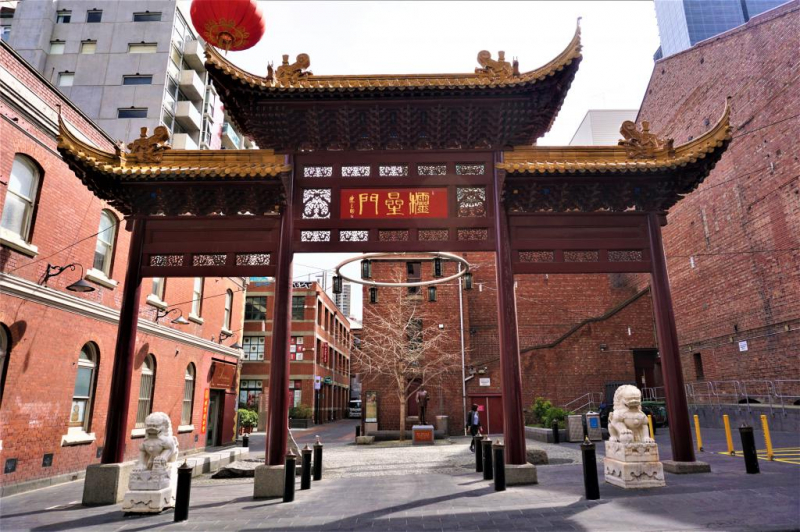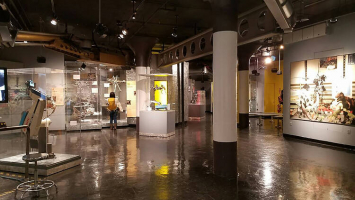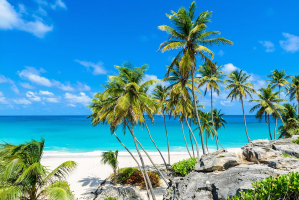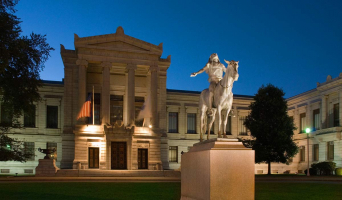Top 10 Best Museums to Visit in the Melbourne
Melbourne is known as Australia's cultural capital, so it's no wonder that the top museums in Melbourne are among the best in the country. There are museums ... read more...dedicated to creative sectors and museums that showcase the unique tale of Melbourne's multiculturalism, with everything from historical heritage to thought-provoking art. If you're visiting Melbourne for the first time, visiting its museums is an excellent opportunity to learn more about the city. The top museums to visit in Melbourne are listed below.
-
The Lyon Housemuseum is a hybrid house and contemporary art museum in Kew, Melbourne, Australia, near Cotham Road. In a specially built structure, the Housemuseum houses the Lyon Collection of Australian contemporary art. On some days throughout the year, the building is available to the public for pre-booked guided tours, school visits, and other activities. A series of public seminars and lectures on contemporary art, architecture, art history, and museology are also held at the Housemuseum. The Housemuseum Lecture is released as a short book each year. The first book in this series, Leon van Schaik's Meaning in Space, was released in 2011.
Since 1990, Melbourne collectors Corbett Lyon and Yueji Lyon have been developing the Lyon Collection. From the early 1990s to the present, it reflects significant components of Australian contemporary art production. It includes approximately 350 paintings, sculptures, installation pieces, photography, and video works. The Collection now houses more than 50 artists, including globally renowned Australians Howard Arkley, Patricia Piccinini, Callum Morton, Brook Andrew, Shaun Gladwell, Daniel von Sturmer, and Matthew Sleeth.
Location: 219 Cotham Rd, Melbourne, Victoria 3101
Website: lyonhousemuseum.com.au

Lyon Housemuseum 
Lyon Housemuseum -
The Melbourne Museum provides a chance to learn about Victoria's genuine history. The museum covers the state's natural environment, cultural history, local communities, and urban development. Drivers heading to Melbourne Museum should take Nicholson Street and keep an eye out for the Royal Exhibition Building and Carlton Gardens since the Museum is located inside their grounds. For an hourly price, daily subterranean parking is provided.
The museum dates back to 1854, when the Government of Victoria, William Blandowski, and others established the "Museum of Natural and Economic Geology". The Museums were incorporated with the Public Library and the National Gallery of Victoria under the Library, Museums, and National Gallery Act 1869; however, when the Public Library, National Gallery and Museums Act came into effect in 1944, this administrative connection was severed, and they became four separate institutions once more.
The Australian Museums Act established Museums Victoria in its current form (1983). Objects linked to Indigenous Australian and Pacific Islander cultures, geology, historical studies, paleontology, technology and society, and zoology are among the roughly 17 million items held by Museums Victoria's State Collections. Museums Victoria also has a library with some of Australia's most valuable and rare scientific books and serials from the 18th and 19th centuries.
Location: 11 Nicholson StreetCarlton, Melbourne, VIC
Website: museumsvictoria.com.au/melbournemuseum

Melbourne Museum 
Melbourne Museum -
ScienceWorks is an Australian science museum in Melbourne. It is a location of Museums Victoria, which manages the state's cultural and scientific holdings. It's in the Spotswood neighborhood. Scienceworks, which opened on March 28, 1992, is situated in a purpose-made facility "designed along industrial lines" near the historic Spotswood Pumping Station, which was erected in 1897 and has a steam engine display.
ScienceWorks covers robots, space, energy, technology, climate science, and every other area of contemporary life, as its name suggests; subjects are separated into themes and age groups. You may do experiments, play interactive games, and engage in seminars, so don't expect everything to be contained behind glass cases. There are activities for guests of all ages, including a program for children under the age of five and plenty of activities for those who are still children at heart. The Melbourne Planetarium, with its 52-foot domed ceiling, reclining chairs, and surround sound, is another attraction at ScienceWorks, featuring 30-minute feature films focusing on a certain astronomical topic.
Location: 2 Booker St, Melbourne, VIC 3015
Website: museumsvictoria.com.au/scienceworks

ScienceWorks 
ScienceWorks -
The Islamic Museum of Australia (IMA) is an Australian community museum located in Thornbury, Victoria. It was established as a non-profit organization in May 2010 with the goal of constructing Australia's first Islamic museum. Through the presentation of artworks and historical items, it strives to highlight the creative legacy and historical contributions of Muslims in Australia and abroad.
The Islamic Museum of Australia, tucked away in the industrial backstreets of one of Melbourne's northern districts, strives to foster cultural diversity. Decypher Architects turned a disused bottling plant into a contemporary gem, complete with stunning administrative offices. Two bridges connect the welcome area to the galleries, which are staffed by the city's friendliest people. Dark corridors connect to brilliant places, which is a great metaphor for the museum's and its founders' goals.
Location: 15 Anderson Rd, Thornbury, Melbourne, Victoria 3071
Website: islamicmuseum.org.au

Islamic Museum of Australia 
Islamic Museum of Australia -
The Australian Sports Museum (previously the National Sports Museum) is a museum dedicated to Australian sports in Melbourne, Australia. It is housed within the Melbourne Cricket Ground. Cricket, Australian rules football, the Summer and Winter Olympic Games, tennis, rugby league, rugby union, soccer, basketball, boxing, and netball all have displays. The Australian Sports Hall of Fame, as well as the Australian Racing Museum and the Melbourne Cricket Club Museum, are all housed within the museum.
The adjacent MCC Museum houses a display of the Melbourne Cricket Club's history. The Australian Racing Museum was integrated into the Australian Sports Museum on October 6, 2010, putting horse racing on par with other important Australian sports.
Location: Brunton Ave, Melbourne, VIC 3002
Website: nationalsportsmuseum.org

National Sports Museum 
National Sports Museum -
The Heide Museum of Modern Art, usually known as Heide, is an art museum located in Bulleen, a Melbourne suburb. The museum, which opened in 1981 and is nestled among sixteen acres of heritage-listed gardens and a sculpture park, contains modern and contemporary art in three unique exhibition structures.
The museum is located on the grounds of a former dairy farm owned by John and Sunday Reed, well-known art patrons. They called the farm Heide after the Heidelberg School, an impressionist art style that emerged in neighboring Heidelberg in the 1880s, after acquiring it in 1934. The Reeds' 19th-century farmhouse, now known as Heide I, became a gathering place for a group of young modernist artists known as the Heide Circle, which included Sidney Nolan, John Perceval, Albert Tucker, and Joy Hester. They are today regarded as leaders of the Angry Penguins, a modernist art movement named after a cultural periodical co-published by the Reeds and poet Max Harris, and are among Australia's best-known painters. Heide's close relationship to this movement is evidenced in many of its displays.
Location: 7 Templestowe Rd, Melbourne, VIC 3105
Website: heide.com.au

Heide Museum of Modern Art 
Heide Museum of Modern Art -
The Immigration Museum is a museum dedicated to the history of immigration in Australia. It is housed at the Old Customs House on Flinders Street in Melbourne, Victoria. Fawkner's Hotel, erected in 1835 by John Pascoe Fawkner, one of Melbourne's founders, stands on the site of one of the city's original buildings. The Long Room, the museum's most important area, is a famous example of Renaissance Revival architecture.
The museum was established in 1998 as a part of Museums Victoria, which manages the state's cultural and scientific holdings. Melbourne Museum (containing the Royal Exhibition Building) and Scienceworks Museum is its sibling museums. The museum presents numerous traveling exhibitions and offers educational activities in addition to its work recording immigrant history. The museum's courtyard is used to hold community events that include cuisine, music, and culture. The Immigration Discovery Centre, where individuals may trace their ancestors, and the Tribute Garden, which honors immigrants from more than 90 nations, are also part of it.
Location: 400 Flinders St, Melbourne, VIC 3000
Website: museumsvictoria.com.au/immigrationmuseum

Immigration Museum 
Immigration Museum -
The Grainger Museum is a repository of materials chronicling the composer, folklorist, educator, and pianist Percy Grainger's life, career, and music. It is located on the campus of the University of Melbourne in Melbourne, Victoria, Australia. Grainger began planning an autobiographical museum in the early 1920s, with the goal of depositing "all really intimate letters or notes in an Australian Grainger Museum, ideally in birth-town Melbourne". Grainger was a linguist who favored the use of a 'Blue-Eyed English' lexicon formed from Anglo-Saxon and Germanic sources. As a result, he normally refers to museums as "past-hoard-houses", but he consented to use the term "museum" in this situation.
Grainger's whips and other items relating to his sadomasochism (which he called the "Lust Branch"), the contents of his bedside cabinet, and a gallery devoted to his mother's suicide are among the displays of original manuscripts and published scores, musical instruments, field recordings, artworks, photographs, books, and personal items. Grainger also employed sound-making instruments to create his unique and experimental "Free music". Grainger communicated with people including Edvard Grieg, Frederick Delius, Cyril Scott, Roger Quilter, and Julius Röntgen, and gathered letters from Wagner and Tchaikovsky, among others, and the archive collection has over 50,000 items of correspondence.
Location: 7-13 Royal Pde, Melbourne, VIC 3052
Website: grainger.unimelb.edu.au

Grainger Museum 
Grainger Museum -
On Russell Street in Melbourne, Victoria, Australia, the Old Melbourne Gaol is a former prison and contemporary museum. It consists of a bluestone structure with a courtyard next to the historic City Police Watch House and City Courts buildings, as well as the Russell Street Police Headquarters. It was built in 1839 and jailed and killed some of Australia's most renowned offenders between 1845 and 1924, including bushranger Ned Kelly and serial murderer Frederick Bailey Deeming. Though it was temporarily utilized as a prison during World War II, it was officially closed as a prison in 1924, with sections of the prison becoming part of RMIT University and the remainder becoming a museum.
The three-story museum houses information and mementos from the inmates and employees, as well as death masks from the executed offenders. Before it was taken in 1978, the museum housed what was thought to be Ned Kelly's skull, as well as the pencil used by wrongfully convicted Colin Campbell Ross to declare his innocence in writing before being hanged.
Location: 377 Russell St, Melbourne, VIC 3000
Website: oldmelbournegaol.com.au

Old Melbourne Gaol 
Old Melbourne Gaol -
The Chinese Museum, also known as the Museum of Chinese Australian History, is an Australian history museum in Melbourne's Chinatown dedicated to recording, conserving, and showcasing Australia's Chinese community's history, legacy, and culture. With a mandate to showcase the history of Australians of Chinese heritage, the museum was founded in 1985. The Victorian Government sponsored a major renovation that was completed in 2010. The museum has also served as a Chinatown Visitor Center since then.
The Cohen Bros. erected the building that now houses the Museum in 1890 and utilized it as a warehouse for furniture manufacturing. It was then sold to Her Majesty's Theatre, which utilized it to store its enormous costume collection. The museum was formally formed in 1984 when the Victorian Government, with the help of the Victorian Tourism Commission, the Chinese Community, and the Melbourne City Council, bought the building from Her Majesty's Theatre. Local and international artists can display work that connects with Chinese culture in a temporary exhibition space.
Location: 22 Cohen Pl, Melbourne, VIC 3000
Website: chinesemuseum.com.au

Chinese Museum, Melbourne 
Chinese Museum, Melbourne































